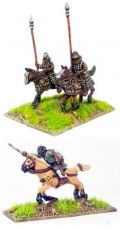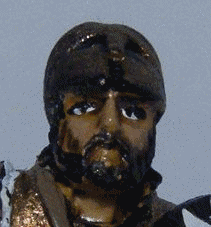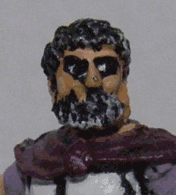Field of Glory Wargaming at Burton Doubles, (Badcon) 2009
Sunday Morning wasn't too bad - for a change. maybe we were all getting old, maybe it was just too cold for us to walk to any decent Nutters All Night Disco branch due to the center or gravity of Burton's nightlife moving away from where we were staying - or maybe the attractions of the gay-friendly real ale establishment across the road were just too tempting on a frosty February night. Who knows...?
Anyways, Game 3 saw us facing .... a Graeco-Bactrian Army who's list is available here
Pictures of Graeco-Bactrian Troops from my Ancients Photo Directory
 |
 |
 |
 |
 |
You can rate the quality of the above figures by clicking on any of the pictures and then clicking on the 5-star voting buttons. Your ratings will be seen by hundreds of other gamers and will help them select the best figures for their armies!
The Bactrians graciously gave us Steppe Terrain, and we therefore set up in a big long line filling the table but thinner on the edges where we were only facing light horse.
The Bactrians deployed with all their pike in the middle, and the cataphracts in the traditional place on one wing, with skirmishing light horse everywhere else. It promised to be a game of no skill and no maneuver, thus playing to our strengths...
The line of Greeks advanced so tidily that we even had a chance to get a shot from the front to show off all their funky shield designs. These very Greeks actually feature in a Guide to Painting Hoplites elsewhere on this site.
The Bactrians were rather more dour, and faced us with a solid block of metal and spearpoints.
The entire Greek line wheeled gracefully towards the Bactrians, as we sought to position our Spartiates against the enemy pike phalanx.
Over to the right the Bactrian light horse pushed forward ahead of their line, however by now we had leant our lesson and swiftly expanded and echeloned to close what little opportunity may have presented itself for them to sneak through.
As the Bactrians also echeloned to our right, our line checked its advance and waited for them to come towards us, simultaneously working the flank of the pike block which was dangerously unprotected in this very open terrain.
The battle soon reached boiling point as the Spartiates piled into the phalanx, using their overlap at this end to good advantage to disrupt the end pike block after surviving the initial combat where the boys in red were slightly disadvantaged in POAs, but made it up in superiority and generalship.
At Impact the Pikemen were:
- +1 POA for being unfragmented men with sticks
- +1 POA for having 4 ranks of Pike
The Spartiates were:
- +1 POA for being unfragmented men with sticks
- Effectively +1 POA for being Superior and having Generals with both units in combat as well.
In melee the Pikemen are:
- +1 POA for being unfragmented men with sticks
- +1 POA for having 4 ranks of Pike
The Spartiates should end up as:
- +1 POA for being unfragmented men with sticks
- +1 POA for being better armoured than the Pikemen
- Effectively +1 POA for being Superior and having Generals with both units in combat as well.
Easy maths....!

Further to our right things were more dicey, as a line of Bactrian heavy metal moved up ready to charge. The worried Greeks braced themselves, all the while thanking the lord that the heavily armoured cataphracts had chosen to charge against the only protected unit in the Greek line !
The maths of the Pike vs Spartan combat had played out according to plan, and the overlapped 8-man pike unit on the end of the line broke and fled, piling the pressure on their colleagues next in line. With the speed of the collapse, and the slowness of the undrilled hoplites extending the Greek flank there was neither time nor opportunity to wheel into the Phalanx's flank
And elsewhere on the table a gradual advance of the thin Greek line shrugged off desultory shooting due to their armour meaning the light horse only scored hits on a 5 or 6. Table was running out for the horsemen from Bactria..
The line of Greeks angled carefully forward, triggering a charge from 3 separate units of Cataphracts but staying out of range of the 4th (in the middle). This gave us overlaps in key places, but it was still a tough fight and with the allied commands troops engaged in 3 places, it was too risky to commit the general to one of the 3 units under his command (as once committed he would be unable to bolster either of the other 2 if needed).
The Spartiates continued to grind down the end of the wavering line of Phalangites, fragmenting the overlapped one and causing generals to come to its aid (the TC was in combat, but the IC also joined in for waver tests). As the cataphracts bounced off repeatedly the phalanx threw some miraculous dice to hang on in the increasingly unequal combat (as they were by now down to 3 ranks and also fragmented - losing their POA's for "men with sticks" and "4th rank of pike").
The Cataphracts were not giving up either, and by now our line of brave hoplites was considerably thinned out and one unit was near to the 50% losses to make it automatically break. But the Cataphracts were also taking casualties, making it harder for them to pass cohesion tests (-1 for 25% losses) At least he allied Spartiates and also the protected unit were holding firm, thanks in no small part to their overlaps on their opponents.
Swinging the camera angle back to the left, the edge of the table loomed large, and no amount of outrageous light horse wiggling could get the Bactrians away from a solid line of spearmen extending to the table edge !
Finally the cataphract vs hoplite battle started to resolve, with 8 hoplites being broken, but a unit of cataphracts also being smashed. On the far flank the Spartiates hung on grimly as they and their protected colleagues fought off the last coherent block of cataphracts.
As the victorious cataphracts pursued the routing hoplites, they in turn were charged in the flank by the waiting Thracian spearmen seeking a bloody revenge on the now already battered cataphract units.
Astoundingly the last pike block had still managed to hang on, and was starting to grind down the astonished Spartiates! After recovering cohesion they inflicted a rare reverse on the Spartans, knocking them down to disrupted just as a unit of victorious cataphracts hove into view ready to deliver a charge in the rear!
Smashed between the pikemen and cataphracts the Spartiates were instantly vaporized... and as the two Bactrian units stood and looked on in amazement at each other, another unit of Spartans girded their loins and prepared to gain a bloody revenge!
The resulting flank charge was just too much for the battered pike block, which broke and fled - but the pursuing Spartans were then themselves caught in the flank by the cataphracts who had avoided the initial combat by millimeters...
The spear wall had by now pushed many units of light horse off table, and with only a single half-unit need to win the game they charged towards the last unit, fleeing it off table but falling short of reaching the enemy baggage. Even the stone-throwing peasants got into the action, taking on Superior Bactrian bowmen - but to no avail.
The Bactrians were also racing towards the Greek baggage as the game shattered into a multitude of disconnected combats on the open plains. The Bactrians only had one real fighting unit still in play, and hardly any units on table at all - but the light horse evading off had saved them many attrition points and the game still had time to play out.

After the stone throwing peasants failed to beat the Bactrian bowmen, the last hope was Spartans vs Cataphracts. The Cataphract unit was tempted into a rash and unwise charge (failing its CMT) and soon the Spartiates were doing what they did best - beating enemy where they had better POAs and outnumbering them 2:1. They killed a Cataphract in impact, and then followed up with 5 hits in melee.
The death roll would decide the game, the Bactrians needing 6 (or more!!) to remain at 50% casualties and save the unit with the last dice roll of the morning session...
Oh well..... A chunky victory to us, but one where we missed out on the extra 5 points for breaking the enemy army by the narrowest of margins.
Post Match Summary
 As
Leonidas, King of the Spartans I wish to strongly protest at the slipperiness of
light horse, and the way that their losses only count as partial once they flee
the table.
As
Leonidas, King of the Spartans I wish to strongly protest at the slipperiness of
light horse, and the way that their losses only count as partial once they flee
the table.
In this game we beat almost everything that was put in front of us, chased a significant proportion of the rest off table and left our opponents emasculated as a credible fighting force. Yet we still failed to record a total victory, due to the vagaries of the scoring system.
I was most pleased by the way the Spartans this time redeemed themselves following the debacle of the last session, and it was only the intervention of the IC who managed to save the last pike phalanx long enough to allow those cataphracts to come back and cause us a headache.
Of course, an undefended flank on a pike block is a rather tempting weak spot, but at the end of the day we took them down in a more manly frontal fashion, partly as our infantry were too slow and unmaneuverable to get in an early flank attack, even on such a gaping target. What I really needed was a couple of units of drilled average armoured MF, possibly with javelins and swordsmen skills to nip round the flanks and help finish them off more quickly really....
However at the end of the day we came damn close to the full victory, and that last dice roll was what cost us in the end. Luck eh?
Hannibal's Post Match Analysis
 To
say that flank was open was an understatement.
To
say that flank was open was an understatement.
It couldn't have been easier if those pikemen had painted "Hit here" (next to an arrow) in big letters on their shields and offered you tea and biscuits whilst you got into position.
But still you took too long in wrapping up that victory, and ultimately it cost you some vital points as it allowed the cataphracts to come back into the game.
The light horse I agree were shocking. They shoot, they move like greased lightning, they can wheel and maneuver like they are teleporting from place to place, and its literally impossible for your army to ever catch them. But you have to commit 3 or 4 units, and even when you manage to sweep them from the field - which isn't easy, as they can choose to get away to the side quite competently - you still only get half a point for each one that goes. That's a bit wrong, even if I say so myself.
ultimately though this was a game of two armies who lined up their best troops opposite each other and charged in. One side won more than the other - and this time it was you.
So don't claim the credit for that. It looked very much to me like the dice gods almost gifted you the victory, and then the dice gods snatched it away again.
So, no skill, and a reliance on luck yet again.
Hardly awe inspiring - even for a breechless Greek eh?
NEXT!!!
The Ancient Army List Index
The Rise of Rome (280 BC to 25 BC) Mid Republican Roman ; Late Republican Roman ; Gallic ; Pyrrhic ; Later Carthaginian ; Ancient Spanish ; Later Macedonian ; Later Seleucid ; Later Ptolemaic ; Attalid Pergamene ; Numidian or early Moorish ; Pontic ; Early Armenian ; Parthian ; Later Jewish ; Illyrian ; Spartacus Slave Revolt ; Bosporan ;
Storm of Arrows - Western Europe in the Later Middle Ages (1300 AD to 1500 AD) Medieval French ; 100-yrs War English (Continental) ; 100-yrs War English (Britain) ; Later Medieval Scots ( Britain) ; Later Medieval Scots (Continental) ; Later Scots Isles & Highlands ; Medieval Welsh ; Later Anglo-Irish ; Medieval Irish ; Low Countries ; Later Medieval German ; Italian Condotta ; Swiss ; Free Company ; Medieval Burgundian ; Medieval Danish ; Medieval Swedish ; Medieval Castilian ; Medieval Crown of Aragon ; Medieval Portugese ; Later Granadine ; Navarrese ; Ordonnance French ; Wars of the Roses English ; Ordonnance Burgundian ; Santa Hermandad Nueva Castilian
Immortal Fire - The Greek, Persian & Macedonian Wars (550 BC - 146 BC)
Classical Greek ;
Early Achaemenid Persian ;
Lydian ;
Thracian ;
Syracusan ;
Early Carthaginian ;
Skythian or Saka ;
Kyrenean Greek ;
Late Dynastic Egyptian ;
Alexandrian Macedonian ;
Later Achaemenid Persian ;
Classical Indian ;
Early Successor ;
Early Sarmatian ;
Galatian ;
Hellenistic Greek ;
Graeco-Bactrian ;
Graeco-Indian ;
Indo-Greek :
Legions Triumphant - Imperial Rome (25 BC to 493 AD) Dominate Roman ; Principate Roman ; Foederate Roman ; Later Sarmatian ; Early German ; Dacian or Carpi ; Ancient British ; Caledonian ; Early Alan ; Jewish Revolt ; Sassanid Persian ; Kushan or Indo-Skythian ; Palmyran ; Early Frankish, Alamanni, Burgundi, Limigantes, Rugian, Suevi or Turcilingi ; Western Hunnic ; Early Visigothic & Early Vandal ; Early Ostrogothic, Herul, Sciri or Taifali ; Early Anglo-Saxon, Bavarian, Frisian, Old Saxon or Thuringian ; Gepid or Early Lombard ; Early Scots Irish ; Early Pictish ; Hephthalite Hunnic ;
Swords & Scimitars - The Crusades (1096 AD to 1311 AD) Early Crusader ; Later Crusader ; Fatimid Egyptian ; Georgian ; Seljuk Turk ; Cuman ; Komnenan Byzantine ; Post Latin Conquest Byzantine ; Ilkhanid Mongol ; Mamluk Egyptian ; Cilician Armenian ; Syrian States ; Khwarazmian ; Ayyubid Egyptian ; Middle Serbian ; Middle Bulgarian ; Medieval Cypriot ; Latin Greece ; Pecheneg ;
Eternal Empire - Eastern Europe and the Rise of the Ottomans (1300 AD to 1500 AD) Early Ottoman Turkish ; Later Ottoman Turkish ; Tatar ; Later Russian ; Later Serbian Empire ; Later Bulgarian ; Later Lithuanian ; Later Polish ; Later Teutonic Knights ; Catalan Company ; Middle Hungarian ; Moldavian or Wallachian ; Albanian ; Timurid, White Sheep Turcoman or Black Sheep Turcoman ; Later Hungarian ; Hussite ;
Decline & Fall - Byzantium and Islam (493 AD to 1071 AD) Early Byzantine; Maurikian Byzantine ; Thematic Byzantine ; Nikephorian Byzantine ; Later Moorish ; Later Visigothic ; African Vandal ; Italian Ostrogothic ; Early South Slav ; Lombard ; Avar ; Arab Conquest ; Early Bulgar ; Ummayad Arab ; Abbasid Arab ; Early North African Dynasties ; Khurasanian Dynasties ; Bedouin Dynasties ; Dailami Dynasties ; Pecheneg ; Ghaznavid ; Western Turkish (includes Khazar);
Wolves From The Sea - The Hairy European Dark Ages Post Roman British ; Early Welsh ; Later Scots Irish ; Merovingian Frankish ; Later Pictish ; Early Slavic ; Middle Anglo Saxon ; Astur Leonese ; Andalusian ; Early Navarrese ; Carolingian Frankish ; Viking ; Magyar ; Great Moravian ; Early Scots ; Rus ; Norse Irish ; Early Medieval French ; Early Medieval German ; Norman ; Early Polish ; Anglo Danish ;
Swifter Than Eagles - The Biblical Book Nubian ; Early Libyan ; Later Sumerian or Akkadian ; Early Nomad Allies ; Old or Middle Kingdom Egyptian ; Hyksos ; Mitanni ; Syro-Canaanite ; New Kingdom Egyptian ; Later Minoan or Early Mycenaean ; Hittite Empire ; ; Middle or Early Neo-Assyrian ; Later Mycenaean or Trojan ; Sea Peoples ; Philistine ; Phoenician Allies ; Neo-Hittite And Aramaean ; Later Hebrew ; Mannaean Allies ; Libyan Egyptian ; Urartian ; Median ; Neo-Elamite ; Proto-Arab Allies ; Cimmerian or Early Skythian ; Neo-Assyrian Empire ; Phrygian Allies ; Kushite Egyptian ; Neo-Babylonian Empire ;
Oaf of Fealty - Early Medieval Europe Feudal Catalan and Early Crown Of Aragon ; Early Hungarian ; Taifa Andalusian ; Feudal Navarrese and Aragonese ; Feudal Castilian Leonese or Portuguese ; Fanatic Berber ; Italo-Norman ; Feudal French ; Imperial German ; Feudal German ; Communal Italian ; Papal Italian ; Early Scots Isles And Highlands ; Feudal Scots ; Early Russian ; Feudal Polish ; Anglo-Norman ; Later Welsh ; Early Lithuanian or Samogitian ; Wendish Prussian or Estonian ; Early Medieval Frisia and Other Free Cantons ; Post-Viking Scandinavian ; Early Plantagenet English ; Later Sicilian ; Early Medieval Irish ; Early Anglo-Irish ; Early Teutonic Knights ; Mongol Invasion ; Early Granadine ; Middle Plantagenet English ;
Empires of The Dragon - China, Korea and Japan Erlitou-Shang Chinese ; Early Northern Barbarian Allies ; Early Zhou Chinese ; Yayoi Japanese ; Early Horse Nomad ; Ko Choson Korean ; Warring States To Western Han Chinese ; Qiang And Di ; Three Kingdoms Korean ; Eastern Han Chinese? ; Three Kingdoms W Jin And S Dynasties Chinese ; Kofun Nara Japanese ; Northern Dynasties Chinese ; Later Hindu North Indian ; Later Hindu South Indian ; Central Asian City States ; Western Wei To Early Tang Chinese ; ; Later Horse Nomad ; Tibetan ; Nepalese Allies ; Parhae Korean ; Late Tang To Five Dynasties Chinese ; Khmer Or Champa ; Thai Allies ; Nanzhao ; Pyu Burmese Allies ; Koryo Korean ; Early Heian Japanese ; Pagan Burmese ; Liao ; Song Chinese ; Xi Xia ; Ghurid Afghan ; Jin ; Late Heian To Muromachi Japanese ; Japanese Warrior Monk Allies ; Mongol Conquest ; Moslem Indian Sultanates ; Medieval Indonesian Or Malay ; Yuan Chinese ; Medieval Burmese ; Ming Chinese ; Yi Korean
Blood and Gold - The Americas Olmec ; Teotihuacan ; West Mexican ; Zapotec or Mixtec ; Toltec ; Chinantec ; Aztec ; Tarascan ; Tlaxcalan Confederacy ; Mayan ; Mochica ; Chanca ; Chimu ; Hatun-Colla ; Canari ; Inca ; Mapuche or Araucanian ; Amazonian Forest Tribes ; Tupi ; Chichimec ; Pueblo Culture ; Mound-Builder Culture ; South-Eastern Woodland Culture ; Timucuan ; Eastern Woodland Culture ; Plains Culture ; Pacific North-West Culture
View My Stats for My FoG Pages























